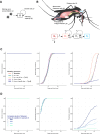Polygenic viral factors enable efficient mosquito-borne transmission of African Zika virus
- PMID: 41168162
- PMCID: PMC12575611
- DOI: 10.1038/s41467-025-64627-0
Polygenic viral factors enable efficient mosquito-borne transmission of African Zika virus
Abstract
Zika virus (ZIKV) is a mosquito-borne orthoflavivirus primarily transmitted among humans by Aedes aegypti. Over the past two decades, it has caused significant outbreaks associated with birth defects and neurological disorders. ZIKV consists of two main genotypes: the African and Asian lineages, each exhibiting distinct biological properties. African lineage strains are transmitted more efficiently by mosquitoes, but the genetic basis for this difference has been elusive. Here, we investigate this question by comparing recent African and Asian strains using chimeric viruses with swapped genome segments. Our results show that structural genes from the African strain enhance viral internalization, while non-structural genes improve genome replication and infectious particle production in mosquito cells. In vivo mosquito transmission is most significantly influenced by structural genes, although no single viral gene alone is decisive. We also develop a stochastic model of in vivo viral dynamics that reflects the observed patterns, suggesting the key difference between African and Asian strains lies in their ability to traverse mosquito salivary glands. Our findings imply the polygenic nature of ZIKV transmissibility has hindered Asian strains from achieving the same transmission efficiency as African strains, highlighting the role of lineage-specific adaptive landscapes in ZIKV evolution and emergence.
© 2025. The Author(s).
Conflict of interest statement
Competing interests: The authors declare no competing interests.
Figures




Update of
-
Polygenic viral factors enable efficient mosquito-borne transmission of African Zika virus.bioRxiv [Preprint]. 2025 Jan 24:2025.01.23.634482. doi: 10.1101/2025.01.23.634482. bioRxiv. 2025. Update in: Nat Commun. 2025 Oct 30;16(1):9594. doi: 10.1038/s41467-025-64627-0. PMID: 39896559 Free PMC article. Updated. Preprint.
References
-
- Boyer, S., Calvez, E., Chouin-Carneiro, T., Diallo, D. & Failloux, A. B. An overview of mosquito vectors of Zika virus. Microbes Infect.20, 646–660 (2018). - PubMed
-
- Petersen, L. R., Jamieson, D. J., Powers, A. M. & Honein, M. A. Zika virus. N. Engl. J. Med.374, 1552–1563 (2016). - PubMed
-
- Baud, D., Gubler, D. J., Schaub, B., Lanteri, M. C. & Musso, D. An update on Zika virus infection. Lancet390, 2099–2109 (2017). - PubMed
MeSH terms
Grants and funding
- ANR-10-LABX-62-IBEID/Agence Nationale de la Recherche (French National Research Agency)
- U01 AI151758/AI/NIAID NIH HHS/United States
- MR/W017059/1/RCUK | Medical Research Council (MRC)
- ANR-16-CONV-0005/Agence Nationale de la Recherche (French National Research Agency)
- 101102733/European Commission (EC)
LinkOut - more resources
Full Text Sources
Medical
Miscellaneous

